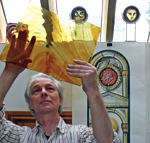Stained-glass maker
Mary Miers talks to some experts at stained-glass making and restoration


Stained and painted glass has featured in houses since at least the 15th century. The designs were mostly heraldic until it became highly fashionable in the 19th century, when mass production for the domestic market resulted in many old techniques being forgotten. One studio that has revived those skills is Williams & Byrne, established by David Williams and Stephen Byrne in 2004. They met at Hardman's, the Birmingham workshop famous for making Pugin's stained glass, where Mr Williams, a former apprentice of Patrick Reyntiens, was manager/designer. Mr Byrne used to work in the City, until he decided he wanted to work with his hands, and the two collaborated on several projects before setting up in partnership. The pair design, paint and restore glass to individual commissions, and also run glass-painting workshops. The majority of jobs are domestic window panes, overlights and panels inset into doors but they also do church work, such as the recent St Cecilia memorial window for St Mary's, Neen Savage. About 30% of their work involves restoring or repairing historic glass, mostly in public buildings and churches, although current jobs include reconstructing a fanlight and panels for a Regency house in Hereford. If possible, the glass is preserved in situ they have recently surveyed an 1844 window by David Evans at St Chads, Shrewsbury, mapping every cracked piece that they hope to retain. Those that are too damaged will be replicated using original materials and methods, a process they call 'forgery of the highest quality'. Following a site visit, Mr Williams sketches several proposals in watercolour. Architectural factors, as well as design and colour, are considered: how, for example, the glass can transform a space by manipulating light and shade. Secular designs range from rural scenes and abstract compositions to decorative or armorial motifs. 'We may take several months getting the lines and shadows right on paper,' says Mr Williams, who, once everything is resolved, prepares a full-scale watercolour showing how each piece of glass will be cut. 'We always use handmade glass it has a texture and depth you don't get with machine-made glass. There are many varieties; we use the English Antique Glass Co where possible.' The chosen glass (plain or coloured) is laid over the drawing and cut into the required shape. Sometimes, it is acid-etched to add texture or remove areas of colour. Next, lines and shadows and features such as faces and hands are applied in paint, sometimes scratching out finer detail with a sharp point. Mr Williams and Mr Byrne have revived a technique that allows them to build up several layers of glass paint, by mixing the media (water and oils), and then to fire the piece just once. This single firing allows for subtler designs, and results in a lovely delicacy of surface and more lustrous finish. Once the glass has been fired, it might be painted on the back with silver nitrate and fired again a technique known as silver staining, which produces the beautiful gold-tinted highlights seen in many old windows. The pieces of the jigsaw are then joined together with handmade lead cames, which are soldered at the joints and 'cemented' with putty squeezed under the flanges, to make the glass weatherproof. Cleaning and polishing must then be done with great care to ensure that every gap is sealed. Once the putty has cured, the glass is ready to be fixed on site, which Williams & Byrne also does itself. Mary Miers Williams & Byrne 01584 856724; www.williamsandbyrne.co.uk Top tips Repairs with household glue or mastic often make the original damage worse Painted glass can be cleaned with de-ionised water and a lint-free cloth Check solder joints and supporting bars and ties regularly to ensure windows remain structurally sound
Exquisite houses, the beauty of Nature, and how to get the most from your life, straight to your inbox.
Country Life is unlike any other magazine: the only glossy weekly on the newsstand and the only magazine that has been guest-edited by His Majesty The King not once, but twice. It is a celebration of modern rural life and all its diverse joys and pleasures — that was first published in Queen Victoria's Diamond Jubilee year. Our eclectic mixture of witty and informative content — from the most up-to-date property news and commentary and a coveted glimpse inside some of the UK's best houses and gardens, to gardening, the arts and interior design, written by experts in their field — still cannot be found in print or online, anywhere else.

